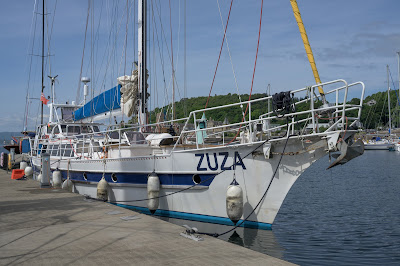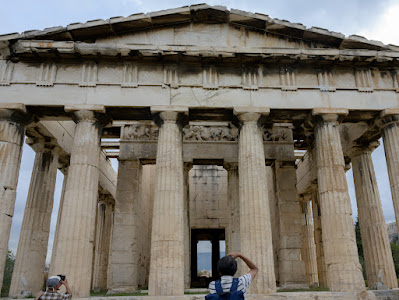30th April - Uyuni and the Train Cemetery
We travelled overnight from La Paz to Uyuni to start our 3 day tour of the salt flats and lakes.
The bus was doing alright until about midnight when the metalled road gave out, to be replaced by rutted dirt. I was not feeling 100% and thought a trip to the toilet, situated at the back of the bus, would be useful. In the dark I did not realise that the aisle was full of luggage and one sleeping person. A tiny elderly Bolivian lady in full skirts and bowler hat still firmly fixed to the top of her head. Having negotiated myself there I found that the flush was not working - most off putting, and then had to get back to my seat, much to everyone else's disgust.
We arrived in Uyuni around 7.00am having now got 2 hours to wait until the tour company opened. Uyuni was deserted except for the decamped bus load so we walked up towards the centre where we were taken hostage by a friendly cafe owner who escorted us to her premises. It was warm inside and crowded as nearly everyone from the bus was there. I did not have the stomach for food, but used their facilities and had some tea. From there we got to the tour company offices and waited till the departure time of 10.30am.
Uyuni is definitely a one horse town, or half a horse might be more realistic. I could imagine Wyatt Earp, or more likely Butch Cassidy toting his gun in the centre of the street. Land Cruisers now take the place of any horses.
We got our stuff packed on top of one of those Land Cruisers and met our driver Pauli, who was a very nice man in his 50's and, I was relieved to find, a very careful driver (there have been lots of horror stories about these trips).
Uyuni grew up as a railway town at the end of the 19th century when the Bolivian government decided that it would be good to build up the infrastructure of the country using steam. In the 4 years up to 1892 there were large numbers of British engineers in the town to oversee the building of the network. The trains were mainly used by the mining companies. However, in the 1940's the mining industry collapsed and most of the old trains stopped running, or rather they were run on lines out to the edge of town where they have been gently rusting ever since. They do get a lot of attention from tourists who use them as climbing frames and photo opportunities. There is still a station in Uyuni with trains arriving from La Paz, Chile and Argentina, but the main industry is tourism.
So our first stop (after a commercial break at the market to buy tourist tat) was that graveyard. The engines have been stripped of any valuable metal and lie at crazy angles, their wheels gradually sliding in to the sand. And it was fun. So much so that I will continue the story of our first day on the salt flat tour in the next blog, and leave you with a bit of train spotting.
The bus was doing alright until about midnight when the metalled road gave out, to be replaced by rutted dirt. I was not feeling 100% and thought a trip to the toilet, situated at the back of the bus, would be useful. In the dark I did not realise that the aisle was full of luggage and one sleeping person. A tiny elderly Bolivian lady in full skirts and bowler hat still firmly fixed to the top of her head. Having negotiated myself there I found that the flush was not working - most off putting, and then had to get back to my seat, much to everyone else's disgust.
We arrived in Uyuni around 7.00am having now got 2 hours to wait until the tour company opened. Uyuni was deserted except for the decamped bus load so we walked up towards the centre where we were taken hostage by a friendly cafe owner who escorted us to her premises. It was warm inside and crowded as nearly everyone from the bus was there. I did not have the stomach for food, but used their facilities and had some tea. From there we got to the tour company offices and waited till the departure time of 10.30am.
Uyuni is definitely a one horse town, or half a horse might be more realistic. I could imagine Wyatt Earp, or more likely Butch Cassidy toting his gun in the centre of the street. Land Cruisers now take the place of any horses.
We got our stuff packed on top of one of those Land Cruisers and met our driver Pauli, who was a very nice man in his 50's and, I was relieved to find, a very careful driver (there have been lots of horror stories about these trips).
Uyuni grew up as a railway town at the end of the 19th century when the Bolivian government decided that it would be good to build up the infrastructure of the country using steam. In the 4 years up to 1892 there were large numbers of British engineers in the town to oversee the building of the network. The trains were mainly used by the mining companies. However, in the 1940's the mining industry collapsed and most of the old trains stopped running, or rather they were run on lines out to the edge of town where they have been gently rusting ever since. They do get a lot of attention from tourists who use them as climbing frames and photo opportunities. There is still a station in Uyuni with trains arriving from La Paz, Chile and Argentina, but the main industry is tourism.
 |
| The oldest train in Bolivia, now in downtown Uyuni |


















Comments
Post a Comment